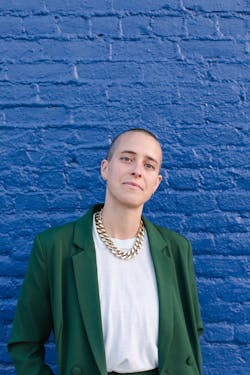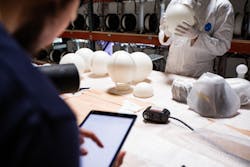Denvir Enterprises Has a Fresh Take on Green Certificates
Green product certificates have changed the game when it comes to prioritizing design’s impact on the Earth, and no one can debate the importance of a third party’s set of eyes. But as with anything in life, our journey toward sustainability is not always so black and white, and Denvir Enterprises is here to make sure our priorities stay on track with the Sustainability Check.
DE is a group of smaller, boutique furniture (and more) producers—all of whom are making incredible strides when it comes to mindful manufacturing. But when their efforts were getting lost in a sea of overwhelming options and pricing requirements when it came to “certifying” their processes and products, founder Holland Denvir decided to do something about it.We caught up with them to learn a little bit more about the journey that led to the Sustainability Check and where it’s going in the future.
What led you to start Denvir Enterprises and the Sustainability Check?
Holland Denvir: I founded Denvir Enterprises in July 2020, right at the prime of the pandemic. I had left my business development job at Hem in December 2019 and was consulting when the pandemic hit. I wasn’t planning on consulting long-term and then everything shut down, including the B2B industry, so I wasn’t sure what I was going to do.
Our partner RAD was very influential in getting us started so I have them both to blame and to thank. They were one of my first consultation clients and urged me to start up a multi-line sales agency. I was not interested at first but eventually decided to give it a go, figuring that I could give the model the well-deserved refresh it needed. It was also a fun challenge to find a way to connect in a meaningful way with architects and designers during the lockdown. Our Box of Delight subscription service was a really successful example of this.
Sustainability Check was also inspired by our clients! As our website highlights, we have so many vendors that are thinking outside of the box but felt excluded by the world of certificates. As their partners, we were tasked with figuring out a way to gather, sort, and share what they were doing in the “DE way.”How do you recruit new members of this collaborative?
HD: I think it’s easy for a lot of us today to say that we care about sustainability, because what kind of person says they don’t care about the Earth? But it’s the people who want to get up and make a difference and put that passion into practice that we want to work at DE and partner with DE. Sustainable practices is always high on the list of criteria when we consider new brands and are always very excited when a new vendor is making game-changer moves in the industry — like BAUX developing biodegradable products. We do look at sustainability from a wider perspective, however, and not just in terms of how “green” a vendor is. We also want to know how they are treating their employees and their greater community.
So what’s your beef with green certificates?
HD: Let’s be clear–it’s not that we don’t believe in what green certificates stand for and aim to achieve. We just believe they aren’t the only way to go. Green certificates are expensive, especially if you have a large catalog. Smaller brands may not be able to afford it, or, rather, it would be a better use of their funds if they invested it in other places such as hiring a team, product development, etc. Many small brands and producers are doing incredibly meaningful work, but without these certifications, they are overlooked and blocked from projects simply because they don’t have the stamp. And it doesn’t necessarily favor big brands either: when you have a huge product line and Greenguard is charging $3000 per product certification application, $1000 per category tested, and another $500 to have it tested every year after–it really begs the question, who is benefitting from these certs? When the goal is to benefit the environment, it shouldn’t boil down to a game of money.
Give us a few examples of how DE members are going above and beyond the sustainability initiatives endorsed by the various certificates out there.
HD:Absolutely. BAUX is definitely one of our strongest brands. Not only have they created three unique materials that are recyclable, reusable and made from environmentally friendly materials, but all their materials also have acoustic properties that help absorb sound for a better, more peaceful working environment. How cool is that? Their original Wood Wool, Pulp, and Recycled PET Felt also come in panels that are modular, producing less emissions in transport and waste in installation.Ege Carpets began a “rewilding project” in 2021, in collaboration with the Danish Nature Fund to transform one million square meters to permanent wild nature. Simultaneously, being proactive rather than reactive to climate change with the expected increased rainfall–one of Ege’s production sites has begun creating two climate lakes, or man-made basins, that aim to reduce the risk of future flooding in their area.
How do you hope the Sustainability Check will squash said beef?
HD: At the end of the day, a green certificate is just a checklist of requirements. But with just a little time and effort, you can see that there are a lot of brands (especially smaller ones) that are doing all that and more. So we hope our Sustainability Check can demystify the idea that green certificates are the “end all, be all.”
What do you hope designers take away from it?
HD: We hope that interior designers and architects will consider manufacturers that are pushing through sustainable practices and having positive impacts in their community but might not have the specific certificate they are looking for; to take a few extra minutes to learn about the manufacturer and what they stand for before going with the product that happens to have the stamp.
We hope that manufacturers will think more holistically about the products they make–the where and how of the raw materials, manufacturing, packaging, transportation, repairability and after.
But overall we hope that it highlights the importance of transparency. We hope that by being as transparent as possible about our brands’ production processes, it creates a new standard for the level of transparency consumers can have, in turn requiring greater accountability from multi-line agencies and brands to do the same. Consumers deserve to know where their products come from and how they are made.
What does the future hold for the Sustainability Check?
HD: Right now, we are undergoing a revamp and reconstruction of our website, but ultimately, we want our Sustainability Check to be a place with a comprehensive breakdown of where and how your products are made and their environmental impact at every step of the process.
We have a lot of work to do, as do our brands, but our goal is to keep moving forward, no matter how daunting the task. Getting your information shouldn’t be an intimidating process, so we aim to have all the information about our brands easily accessible whether you're a D2C consumer or an architect. Lastly, we hope it can be a model for similar sustainability initiatives for other brands and agencies in the future.




